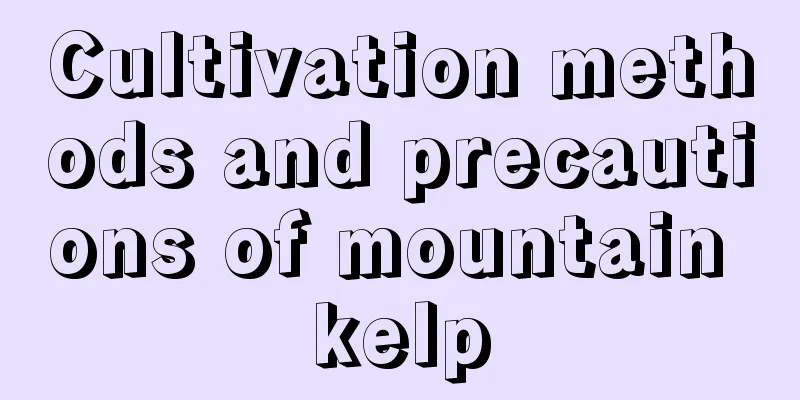Cultivation methods and precautions of mountain kelp

1. Maintenance methods1. Light: Kelp is a light-loving plant and should be given sufficient sunlight. In summer, it is necessary to shield it from strong light to avoid being exposed to the sun. But don't let it get too shaded, otherwise the leaves will become limp. 2. Temperature: It is a plant that likes high temperatures and is suitable for growing in an environment of 20-28℃. It has some cold resistance and can continue to grow above 10℃ and can withstand short-term low temperatures around 0℃. 3. Soil: It has no requirements for the soil. It is best to use loose, acidic soil with good drainage. Also, the soil must be disinfected before use. 4. Water: Water it once or twice a week during the spring and summer, and once every 3-4 days in the autumn. After it enters a dormant period in winter, you can water it once a week. 2. Breeding techniques1. Repotting: Repotting is necessary after two to three years of maintenance, because the air permeability of the soil will deteriorate if the time is too long. When repotting, you need to change the soil, remove the plant from the pot without damaging the roots, and replant it. 2. Reproduction: Kelp can be propagated by sowing. The temperature should be kept at around 20-25℃ during sowing. Buy seeds of good quality, sow them evenly, and they will germinate after 15 days. 3. Problem diagnosis and treatment1. Leaf spot disease: At the beginning, there will be black spots on the leaves, and the spots will continue to expand, causing the leaves to dry up. While pruning the diseased leaves, you should also spray medicine. You can use thiophanate-methyl or carbendazim for prevention and control. 2. Soft leaves: This phenomenon usually occurs because there is not enough light or too little fertilizer. It should be given plenty of sunlight and adequate fertilizer. IV. Other issues1. Can it be raised indoors? It likes sunlight, but it can also be raised indoors, but you must choose a location with good light. 2. Is it edible? Information on kelp shows that it is non-toxic, but it should not be eaten. Just keep it at home and take good care of it. |
<<: Cultivation methods and precautions of Amomum villosum
>>: The cultivation methods and precautions of tamarind
Recommend
Red flesh apples bear fruit in several years
Introduction to growing red flesh apples Red-fles...
How do dahlias survive the winter?
Dahlia is a plant of the Asteraceae family and th...
When is the best time to sow petunias?
How to sow seeds Temperature conditions The suita...
Is Begonia suitable for indoor cultivation?
Is it suitable To answer this question, we first ...
Can mugwort be planted in the yard?
Can I grow mugwort in the yard? Mugwort can be pl...
Should I use a large or small pot for my fortune tree?
Should I use a large or small pot for my fortune ...
Cultivation methods and precautions of Osmanthus fragrans
Pot soil Osmanthus prefers slightly acidic, well-...
Can spoiled rice wine be used as fertilizer?
Spoiled rice wine as fertilizer Spoiled rice wine...
Are roses suitable for deep or shallow pots?
Should roses be potted in deep or shallow pots? I...
Can okra seeds be planted directly?
Can okra seeds be planted directly? Okra seeds ca...
How to make persimmon sprout quickly
Persimmon germination environment Remove the pulp...
The benefits of breeding Luanfeng Jade
The benefits of breeding Luanfeng Jade Horticultu...
When and how to transplant orange trees The best time to transplant orange seedlings
Orange trees can be transplanted in spring before...
What kind of soil is good for growing osmanthus? How to change the soil for potted osmanthus
1. What kind of soil is good for growing Osmanthu...
How to propagate Fuchsia
1. Cutting method 1. Generally, except for the do...









